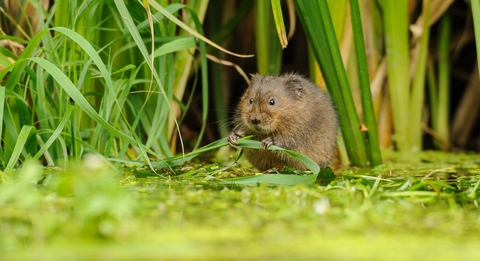“No animal, according to the rules of animal-etiquette, is ever expected to do anything strenuous, or heroic, or even moderately active during the off-season of winter.”
Surviving winter, a water vole’s guide.
As summer turns to autumn and temperatures gradually lower, water voles stop their breeding activities and begin to make their preparations for the winter. Unlike some of their rodent cousins, water voles do not undergo true hibernation but are intermittently active throughout the winter in between periods of dormancy known as ‘torpor’ during the coldest periods. For this reason, water voles have to make preparations to keep themselves warm, dry and fed until the Spring.
Even in summer, water voles need to eat up to 80% of their body weight every day to maintain their condition. Between the end of the breeding season and the onset of winter water voles are even more food focused than usual and prioritise putting on as much extra weight as they can. This not only helps keep them warm but provides internal energy stores to see them through periods of torpor and low activity. Therefore, diverse and abundant autumnal vegetation is a key resource in their habitat.
Throughout the breeding period water voles maintain strict territory boundaries. Male territories will often overlap those of their mates but female-female and male-male territory boundaries are vigilantly maintained and aggressively defended. Once breeding has ceased, however, there is no need to waste so much energy defending these borders and instead a water vole colony will begin to co-habit in their burrows. As this year’s juveniles will not have dispersed very far these groups are often closely related.

Water Vole (Arvicola amphibius), Kent, UK - Terry Whittaker/2020VISION
Water voles collect underground stores of vegetation to feed from throughout the winter, made up of high energy and long-lasting items such as tubers, roots and bulbs. However, if there is a mild spell of weather, they may also venture out of their burrows occasionally to forage, favouring nutrient and energy dense things like willow bark.
Finally, a water vole needs to choose their over-wintering sites wisely. High rainfall and snowmelt can cause flash flooding events over winter and being washed out of their burrows in mid-winter will cost a water vole colony dearly.
Despite their best efforts, winter is tough and there is around a 70% mortality in the winter months in wild water vole populations. Often this is most noticeable affects older adults who are exhausted by the breeding season and young born at the end of the summer that are underweight. This is why, when water voles are collected from donor populations, trapping is conducted in early autumn and the voles are weighed to ensure that only the youngest and lightest water voles (and therefore the least likely to survive) are removed from the wild.

